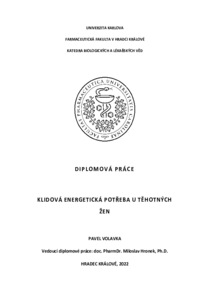Klidová energetická potřeba u těhotných žen
The resting energy need in pregnant women
rigorózní práce (OBHÁJENO)

Zobrazit/
Trvalý odkaz
http://hdl.handle.net/20.500.11956/179585Identifikátory
SIS: 250119
Kolekce
- Kvalifikační práce [6957]
Autor
Vedoucí práce
Oponent práce
Kovařík, Miroslav
Fakulta / součást
Farmaceutická fakulta v Hradci Králové
Obor
Farmacie
Katedra / ústav / klinika
Katedra biologických a lékařských věd
Datum obhajoby
22. 2. 2023
Nakladatel
Univerzita Karlova, Farmaceutická fakulta v Hradci KrálovéJazyk
Čeština
Známka
Prospěl/a
Klíčová slova (česky)
klidová energetická potřeba, graviditaKlíčová slova (anglicky)
resting energy need, pregnancyCíl práce Cílem této diplomové práce bylo stanovit klidový energetický výdej (REE) těhotných žen s využitím nepřímé kalorimetrie, nalézt souvislosti s ostatními sledovanými parametry a výsledek porovnat s podobnými studiemi. Metodika Klidový energetický výdej byl vypočítán spotřebou kyslíku a produkcí oxidu uhličitého metodou nepřímé kalorimetrie. Nepřímá kalorimetrie byla prováděna pod kanopou v klidu na lůžku, bez rušivých elementů, po dvanáctihodinovém lačnění. Studie se zúčastnilo 10 zdravých těhotných žen. Vyšetření probíhalo celkem ve třech období gestace (21.-27., 31.-32., 36.-37. týden). Výsledky Zjistili jsme, že klidový energetický výdej byl zvyšován s délkou těhotenství. Medián REE byl při jednotlivých vyšetření následující: 1412 kcal/den při prvním vyšetření, 1697 kcal/den při druhém a při posledním vyšetření 1902 kcal/den. Prokázali jsme statisticky významné korelace REE s tělesnou hmotností a REE s netučnou tělesnou hmotou (FFM). Závěr Těhotenství je náročný proces, při kterém dochází v ženském těle k mnoha změnám. Studií jsme potvrdili nárůst REE s maximem na konci těhotenství. Z výsledků je patrné, že odhadované hodnoty REE a naměřené hodnoty REE jsou odlišné. Klíčová slova: klidová energetická potřeba, gravidita
Background The aim of this work was to determine the resting energy expenditure (REE) of pregnant women using indirect calorimetry. Find connections with other monitored parameters and compare the result with similar studies. Methods The resting energy expenditure was calculated by oxygen consumption and carbon dioxide production by indirect calorimetry. Indirect calorimetry was performer under a canopy at rest in bed, without disturbing elements, and after 12hours of fasting. The study involved 10 healthy pregnant women. The measurements during pregnancy were taken three times (21.-27., 31.-32., 36.-37. week). Results We found that resting energy expenditure increased with the length of pregnancy. The median of the REE on each examination was on the first measurement 1412 kcal/day, on the second measurement 1697 kcal/day, and the last measurement 1902 kcal/day. We found a statistically significant correlation of REE with body weight and REE with fat-free mass (FFM). Conclusion Pregnancy is a difficult process with many changes in a women's body. The study confirmed an increase of the REE with a maximum at the end of pregnancy. The results show that the estimated values of the REE and the measured values of the REE were different. Key words: Resting energy need, Pregnancy
